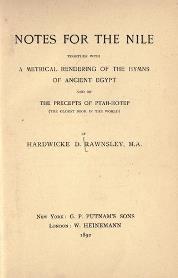| Main » Ad Board » ДРЕВЕН ЕГИПЕТ И АФРИКА » Египтология и история на откритията |
Hardwicke D. Rawnsley - Notes for the Nile
| 17.09.2022, 07:04 | |
Бележки и коментари за пътуването из Египет по река Нил на английския пътешественик Хардуик Дръмънд Раунзли (1851-1920). Описанието е придружено със свободен поостарял метричен стихов превод на колекция значими древноегипетски химни и един от най-старите сборници с нравоучителни наставления: поученията на Птахотеп. - на английски език, от Google Drive, формат PDF. Сваляне с ляв бутон (downloading by left button) от страницата на предоставящия сървър, после през бутона стрелка надолу/after by down arrow button.АЛТЕРНАТИВЕН ЛИНК / ALTERNATIVE LINK: - на английски език, от Internet Archive, формат PDF. Свалянето става с десен бутон (downloading by right button) и Save as...
| |
| Views: 410 | Placed till: 17.10.2022 | Rating: 0.0/0 | |

